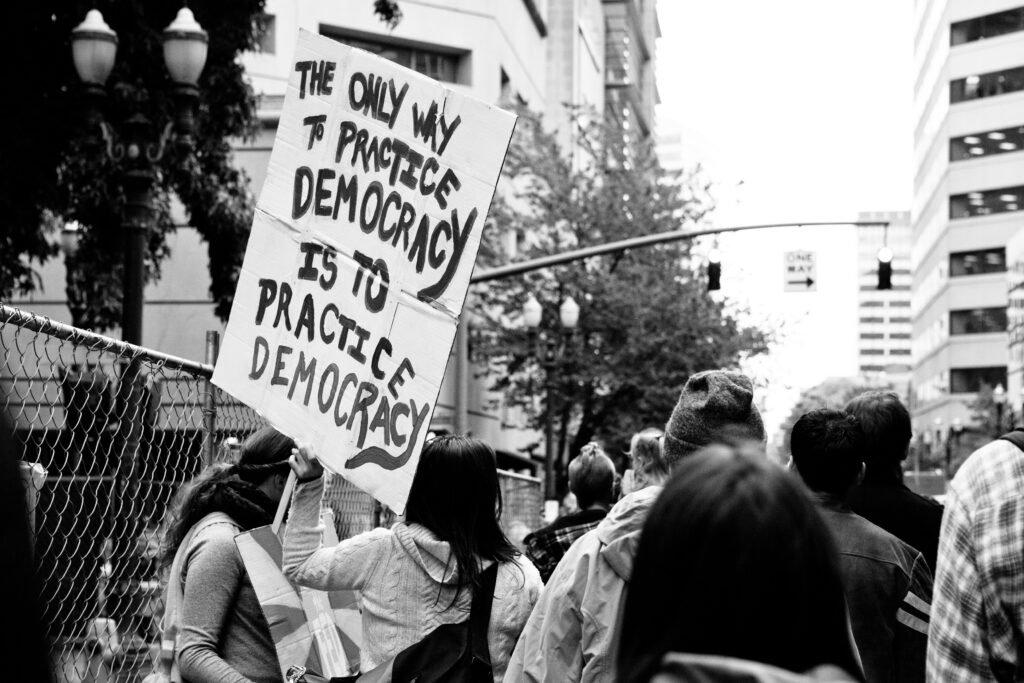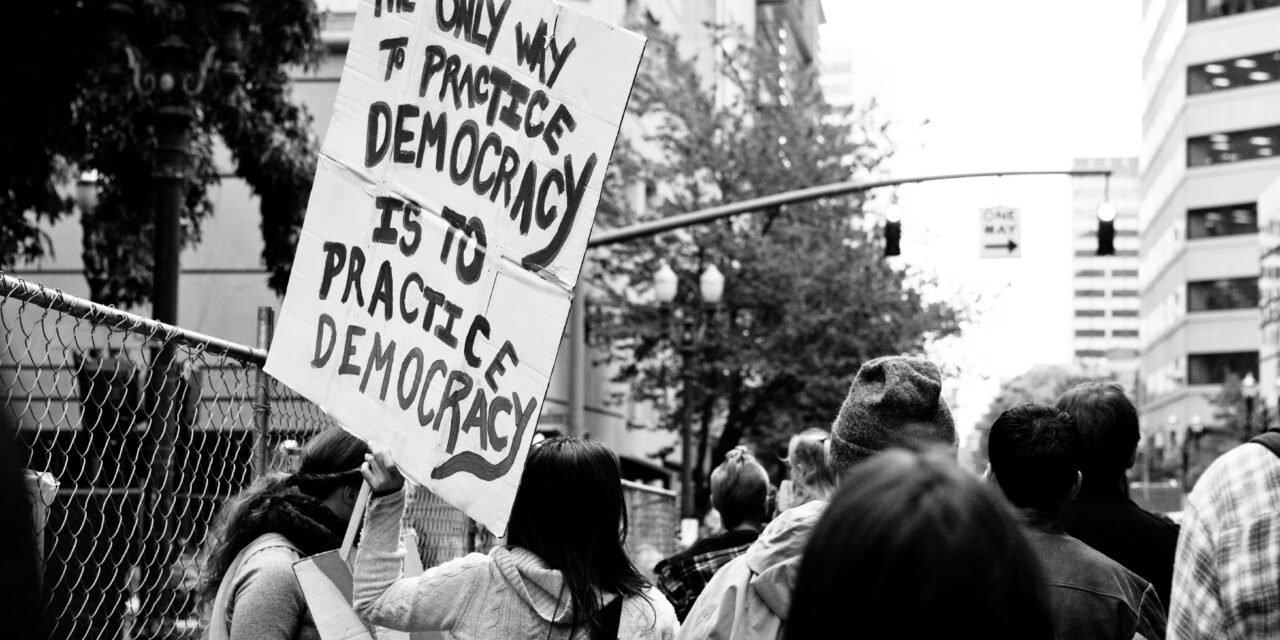
The impending U.S. presidential election looms large in the minds of many around the world as a fight for democracy. We are being reminded once again of just how fragile this experiment is: to be a democratic society that purportedly stands for freedom, equity, and justice. At the heart of the struggle is race. The fight for a multiracial democracy in the U.S. has been marked by violent clashes and systemic attempts to maintain white male domination, most notably since Reconstruction, a period after the Civil War when the U.S. government tried to address both the destruction of slavery and the preservation of the nation. Sadly, history continues to repeat itself.
Two recent books shed light on our sordid history of attempting to thwart free and fair elections:
- Tyranny of the Minority by Harvard Professors Steven Levitsky and Daniel Ziblatt
- America’s Deadliest Election: The Cautionary Tale of the Most Violent Election in American History by CNN journalist Dana Bash with David Fisher
Levitsky and Ziblatt cite several examples — from 1930s France to present-day Thailand — to help us understand how and why political parties fight against democracy, and draw parallels to what is happening now in the United States. One of the most chilling examples cited in the book is the 1898 coup and massacre in Wilmington, North Carolina. Bash’s book reveals the little-known story of Louisiana’s contentious and violent 1872 gubernatorial election — a quarter century before the Wilmington coup.
These events are so similar to what we are experiencing now that it is scary.
The 1872 Louisiana governor’s race was a pivotal moment in the Reconstruction era, and a symbol of the intense racial and political conflicts of the time. This election was fiercely contested between Republican William Pitt Kellogg (representing the more liberal party during this era) and Democrat John McEnery.
Kellogg’s platform was built on the principles of civil rights, vowing to continue the progress made since the end of the Civil War. On the other hand, McEnery represented the Democratic Party, which at the time had aligned itself with the interests of former Confederates and white supremacists. His supporters sought to restore the social and political order that existed before the war. Is this what underlies the “Make America Great Again” mantra?
The election was marked by widespread voter intimidation and violence, primarily orchestrated by white supremacist groups aimed at suppressing the African American vote and ensuring a Democratic victory. In many areas, African American voters were threatened, attacked, and in some cases, even killed. Both sides accused each other of electoral malpractice, leading to a chaotic and disputed outcome. The results showed a narrow victory for McEnery, but Kellogg contested this, pointing to widespread voter suppression. The federal government intervened, with President Ulysses S. Grant recognizing Kellogg as the legitimate governor. This decision was unpopular among many white Louisianans, leading to a dual government in which both Kellogg and McEnery claimed the governorship. Does any of this sound familiar?
The contested Louisiana election was significant in foreshadowing the eventual end of Reconstruction and the rise of Jim Crow laws systematically disenfranchising African Americans.
More than 25 years later, there was a similar occurrence in Wilmington, North Carolina — a city with a majority African American population and a thriving Black middle class. African Americans were an integral part of the city’s political, economic, and social life. Many Black men in Wilmington were not only voting, but also holding public office — thanks to the gains of Reconstruction and the passage of the 15th Amendment, which prohibited racial discrimination in voting rights.
In the early 1890s, the multiracial Fusionists were an alliance between the state’s Populist Party and the Republicans (again, the Republican Party was the more liberal during this era). The Fusionists appealed to both poor white farmers and African Americans. Together, they worked towards a multiracial political movement. The Fusionists successfully elected several Black leaders, including aldermen, police officers, and other local officials. The success of Fusion politics represented a major step toward a multiracial democracy in the South.
However, the rise of Black political power in Wilmington and other parts of North Carolina ignited fierce opposition from the state’s conservative Democratic Party, which was dominated by white supremacists. Many Southern Democrats were determined to maintain white supremacy and viewed the political empowerment of African Americans as a direct threat to their control. To regain power, the Democrats employed a campaign of fear, racism, and violence.
We see the same attempts today to ensure power stays in the hands of a few with voter suppression attempts, intimidation at the polls, disinformation, and outright lies. As just one example, Rudy Giuliani was ordered to pay $148 million in restitution to two Georgia poll workers who he falsely accused of rigging the 2020 election. (He publicly said that he has no regrets for doing so.)
In 1898, the Democratic Party launched a brutal white supremacist campaign to retake political control of Wilmington and the state of North Carolina. They used newspapers, political rallies, and speeches to stoke fears of “Negro domination” and painted Black political participation as dangerous to white society. This behavior can be compared to the recent unfounded attacks on Haitian immigrants who are legally living in Springfield, Ohio. Donald Trump has vowed mass deportation of these people, whom he characterizes as “dangerous.” He and other far right politicians continue to spread lies and make inflammatory comments about their political opponents.
NPR reported that based on their fact-checking, in a recent one-hour news conference, Trump told 162 lies or distortions. As with the conservatives in Louisiana in 1872 and Wilmington in 1898, he is prepared to dominate by any means necessary. This was certainly evidenced by the violent insurrection at the U.S. Capitol in 2021, and his rhetoric now, which is planting the seeds for more violence — whether he loses or wins the election. As reported by The Washington Post, he threatened on his Truth Social media platform to jail people including donors and election officials who “cheated.” He declared: “[These people] will be sought out, caught and prosecuted at levels, unfortunately, never seen before in our country.”
Much like the Capitol insurrection in 2021, violence erupted in Wilmington on November 10, 1898, in what has been called the only successful coup in American history. On that day in 1898, a group of armed white men marched into Wilmington with the explicit intent of overthrowing the legally elected Fusionist government. The mob, numbering in the hundreds, targeted prominent Black citizens and political leaders, forcing them to flee the city under threat of death.
In addition to the political coup, the white supremacists carried out a massacre. They burned down the offices of The Daily Record — the city’s Black-owned newspaper, which had been critical of the Democrats’ campaign of fear. The mob went on to terrorize Black neighborhoods, killing an unknown number of African Americans, with estimates ranging from dozens to over a hundred. While the 2021 attempted coup was not successful in overthrowing a free and fair election, five police officers and four people in the crowd lost their lives, and others were seriously injured.
Despite the 1898 coup being illegal and unconstitutional, there were no federal investigations or prosecutions of those responsible. While many have been prosecuted for the 2021 attempted takeover, Trump has still not faced accountability for his role.
The legacies of Louisiana and Wilmington are stark reminders of how white supremacists were and are still willing to use violence and terror to maintain racial hierarchy and political control — undermining the democratic ideals of equality and representation.
Population shifts and growing political clout among people of color are engendering fear among those who are hell-bent on keeping people of color, immigrants, and LGBTQ+ folks out of power. According to the 2020 census, non-Hispanic white men make up only 30% of the population. People who identify as something other than white make up 40% of the population — a 10% increase from the 2000 census. Today, we have the most racially and ethnically diverse Congress in history. Twenty-eight percent of the House and 12% of the Senate identify as Black, Latine, Asian American, American Indian, Alaskan Native or multiracial. More than one-third of the top 100 cities in the U.S. are governed by Black mayors (though they are only 3.8% of all mayors). Latine and Asian mayors make up 7.8% and 7.7% of incumbents, respectively. While there are only three sitting governors of color, there are 13 BIPOC lieutenant governors. The number of LGBTQ+ elected offices has doubled since 2017. While these numbers are still small, they are growing. Fear among white people and white men in particular who wield the most power has given rise to the increased disinformation and to ideas like Great Replacement Theory and Project 2025, a sweeping conservative manifesto that rails against immigration, DEI and other policies aimed at advancing a multi-cultural democracy.
Voter suppression is alive and well in this election cycle. According to the Brennan Center for Justice, 28 states will face restrictions at the ballot box in this presidential cycle that they did not in 2020. The John R. Lewis Voting Rights Advancement Act was first introduced in 2014 to restore and strengthen parts of the Voting Rights Act of 1965 partially struck down by the Supreme Court in 2013. These protections gave the federal government the right to review states with histories of discriminatory voting practices by a federal court or the Department of Justice. The John R. Lewis Voting Rights bill has yet to pass due to conservative opposition.
We must be vigilant and diligent this election season. As Michelle Obama encouraged at the Democratic National Convention, do something! The Winters Group Learning and Innovation Manager Leigh Morrison shared some key actionable steps in her recent post for The Buzz, “How to Not Lose an Election.” The only thing I would add to Leigh’s advice is to learn about the history of democracy in this and other countries to better understand how we got to where we are today and what is at stake. #WeAreNotGoingBack



















